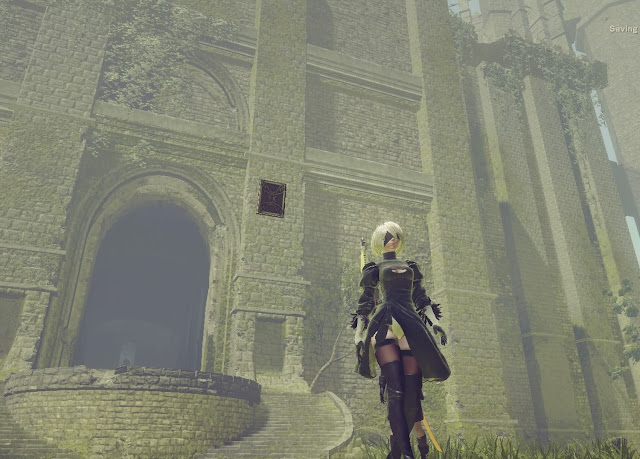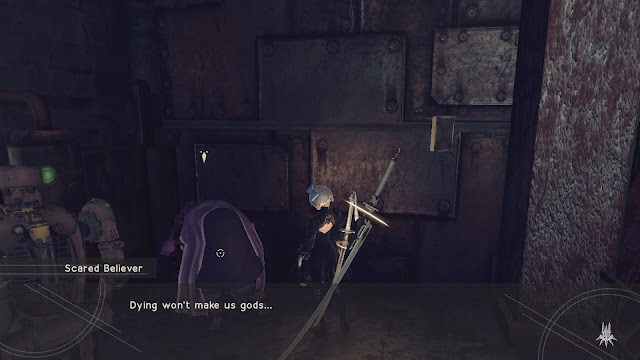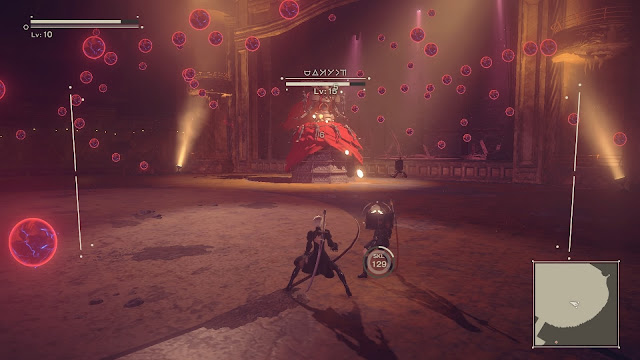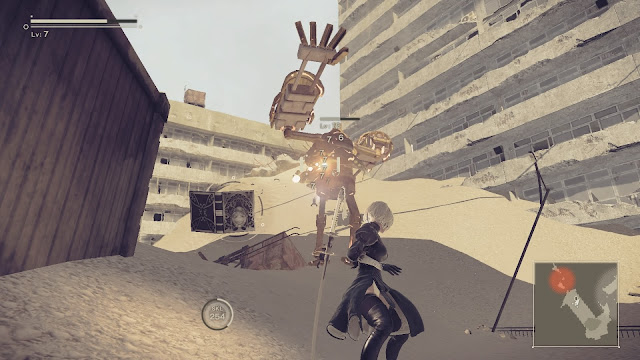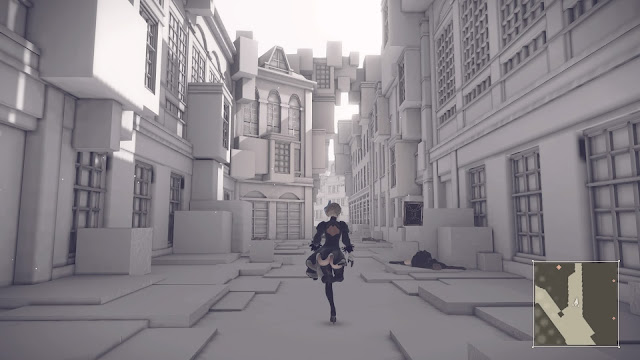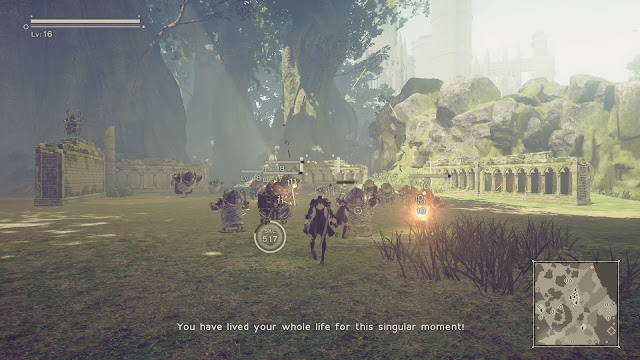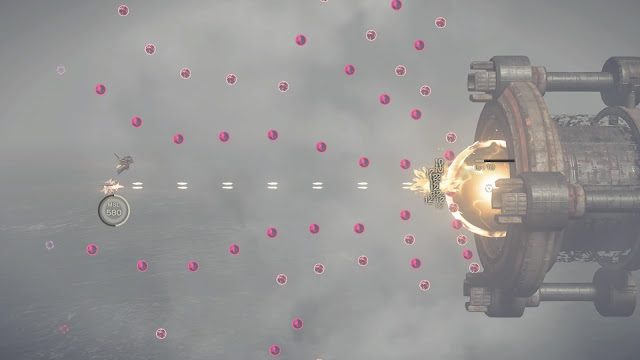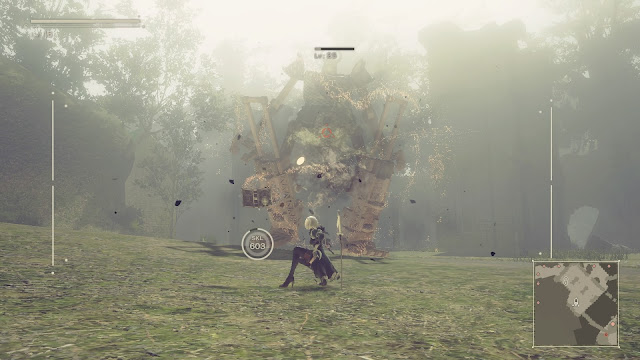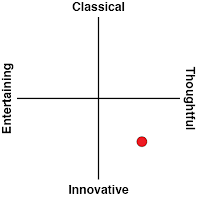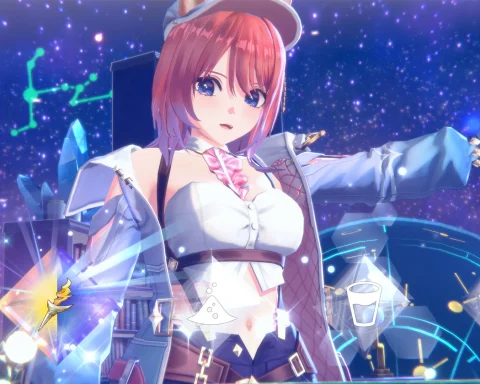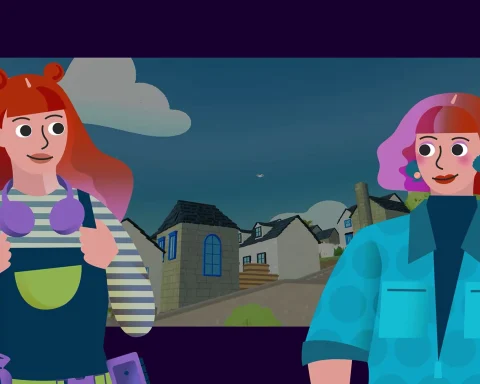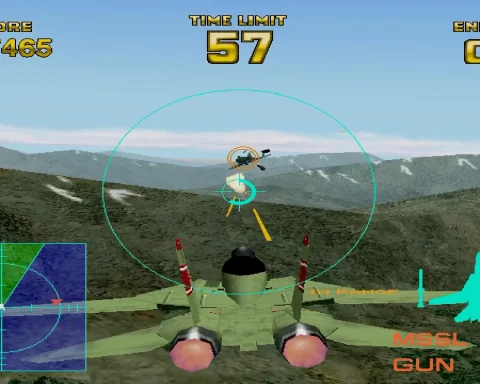Review by Matt S.
The opening line of dialogue in NieR: Automata could have been pulled directly from Nietzsche or Kierkegaard, if those men were militant androids about to go to war with an army of genocidal robots.
Related reading: On why NieR: Automata’s predecessor was the best game of all time before this one came along.
“Everything that lives is designed to end. We are perpetually trapped in a never-ending spiral of life and death. Is this a curse? Or some kind of punishment? I often think about the god that blessed us with this cryptic puzzle, and wonder if we’ll ever have the chance to kill him.”
So starts NieR: Automata. Coming to us from the mind of one of the games industry’s true auteurs, Yoko Taro, the game is a mesmerising combination of rich philosophical thinking and deeply human emotion and storytelling. In combination with PlatinumGames, Taro’s latest development partner, it also offers visceral, dynamic, exciting combat. It’s the smartest game you’ll ever play, and it effortlessly replaces its predecessor as the closest that a game has come to offering genuine literary merit. It’s wonderful, intense, and beautiful, and, with no exaggeration, the best game I’ve ever played.
On philosophy and 2B
The quote above is so potent because it immediately sets up the storytelling structure for the entire experience, making it clear that dialogue does not exist purely for the superficial reason of pushing the narrative forward; it has purpose and depth all to itself. This game’s overall narrative focuses very closely on the core existentialist themes that the aforementioned philosophers made central to their work. On the one hand it explores what is the fundamental nature of humanity; on the other, more importantly, it also explores what is our relationship to “God” – not God in the literal sense, but rather the idea, or concept, that there’s greater meaning and purpose in the universe which, firstly, we can analyse and understand, and secondly, we can participate in. Generally speaking existentialists arrived at the belief that there is no purpose to any of it – this is where Nietzsche’s famous “God is dead” quote comes from – and that the futility of searching for a meaning to life is fundamentally counter-intuitive and absurd.
And yes, for people playing along, that’s where absurdist art, such as Samuel Beckett’s masterpiece, Waiting for Godot, and Albert Camus’ novel, The Stranger, came from. If we were looking for a game to join that tradition, then NieR: Automata would be the game to do it. It’s been decades since existentialist thinking was the in-vogue philosophy exercising the great minds of the world, but Taro-san has managed to modernise its core precepts to give a look at existentialism that remains relevant and thought-provoking even in this day.
The world was effectively destroyed, some centuries ago, by an invading force of aliens that sent armies of robots into battle for them. What was left of humanity was pushed to the moon and, in a desperate bid to fight back, humans created androids to send down to planet Earth and look for ways of destroying both the robots and aliens.
At the start of the game, you’re in control of android number 2B. She doesn’t have a real name, just 2B. That in itself is a clear reference back to Hamlet, Shakespeare’s play that dealt with the existential crisis centuries before Kierkegaard devised a word to describe the phenomenon. As an android, this beautiful woman is not meant to feel emotions or have any care beyond the successful completion of her mission.
That, of course, lasts for all of about twenty minutes in the game. She’s partnered with 9S, a male android that could be her twin (to emphasise the uniformity between androids), and they very quickly form a bond. The emotional connect between the two gives us, as players, something of substance to hook us into the whole experience and make us care. It’s also the first sign that the synthetic beings of this world can have emotion, that it’s not exclusively the purview of organic beings; which is a theme the narrative drums on about with a smooth rhythm throughout the entire experience.
9S and 2B’s enemies are the robots that have remained on earth for all that time and have made it their home. These robots live in harmony with nature, which has, over the centuries, reclaimed the cities of the world, turning crumbling skyscrapers into a new jungle. Initially the duo assume that the robots are mindless killing machines; this is what their human masters have told them. Not that we have any access to the humans, as all commands are relayed from the humans to the androids via the commander of the space station that functions as their home midway between heaven and earth. But it is nonetheless known that the robots are “just machines,” and that killing them poses no moral conundrum whatsoever.
It doesn’t take long for those assumptions to be thrown right out of the window. Many robots in the world simply wander around ignoring the androids if they don’t attack first. And then comes the bombshell that they can communicate with one another, and indeed with the androids, and suddenly the idea that these are just dumb machines that can be slaughtered with impunity is something that needs to be questioned. Are they still the enemy? Assuredly. But now there needs to be an explicit reason to go into battle with them, as basic morality applies to the rules of war: you can’t just kill something intelligent without proper justification. I know that as soon as I discovered that the machines were intelligent, I stopped commanding 2B to attack the ones that didn’t attack her first. It’s not something I thought about, it’s just something I did. Taro-san had me questioning my behaviour almost immediately. Besides, the peaceful robots have a childlike, innocent air that made the very thought of harming them deeply uncomfortable to me.
Related reading: An interview with Yoko Taro on NieR: Automata, and his sense of storytelling and art.
Deeper meanings
In addition to the game’s main plot, which is quite touching by the end, filled with vibrant, interesting characters and lore, the game’s narrative offers a series of deeper discussions on a range of themes, all of which fit with those cryptic questions of life that 2B references right from the outset. I have to emphasise that the below are just a few of the game’s themes. As with all great works of art, different people will notice and interpret the same thing differently. Below is what I took to be the key themes in NieR: Automata. What you will see will be different.
At what point do “people” become people? This is one of the greatest moral discussions of our modern times, as we start to grapple with things like AI and robots, that could well mean we are no longer the only thinking entities on the planet. Are robots and AI capable of independent thought, emotion, even religion? And if they are, or if they get to the point where they are (as they do in NieR: Automata), does that make them “people?” When we see a robot wearing the clothes of antiquity (that people who played the previous NieR will actually recognise), is it merely imitating human modesty, or is it developing its own traditions, sense of aesthetics, and idea of beauty? When robots throw themselves at 2B and 9S to protect something (without spoilers: in NieR: Automata, they do so both to protect a tangible thing and an ideology), is it simply programming, or is it driven by similar biological impulses to what humans experience when we feel the need to throw away our lives for a cause?
It’s also worth noting that 2B and 9S themselves are not humans, but rather androids, created in the likeness of humanity. They certainly feel human concepts such as love, loyalty, anger and pain, making that line between robots and humans all the more tentative and arbitrary; the kind of arbitrary that just has to be challenged. There’s certainly the sense, when playing, that Taro-san believes that intellect and “personhood” extend beyond biology, at least in theory, and that there is a point where AI and robots should be afforded the same moral rights and responsibilities as humans.
2) On the idea of God and religion, Yoko Taro waxes very philosophical indeed. This is the most challenging part of the game’s narrative to actually discuss in the context of a review, as it is potentially filled with spoilers. What I can say is that, in different ways, both the androids and the robots have developed their own distinct religions, or “faiths,” and the purpose of having both is, again, a discussion and debate that the game inhabits to the fullest. Androids have ultimate faith in their human creators, who occupy a role very similar to God; they exist in the same “heaven-in-the-sky” where current real-world believers believe their Gods to exist, and just like those believers, NieR’s androids have no contact with their “Gods”. Like the gods of humanity, NieR: Automata’s androids trust that a select few “commanders” can interpret the commands of their human creators and provide guidance on how they should live their lives and achieve their missions. And, as with our religions, there is no room to challenge the commands of their “Gods”. It’s the classical interpretation of religion, in other words: Gods make “people,” who then are to live their lives in subservience to and according to the word and command of God.
Again, without giving too much away, the robots form the basis of their religion around deities of their own construction. This is an entirely different take on religion, but it originates in the argument that “people” create a God from their vision in order to give voice to their ideals, morals, and beliefs, and to justify their subsequent actions. Of course, there are questions here, too: does this process, of creating God in order to create a meaning for existence, behaviour, and morality really achieve this purpose? In contrast to the robots, the androids are explicitly driven towards a real goal. The robots, perhaps, represent a more enlightened, questioning, understanding of “God” – an existential one where they, like Nietzsche, believe religion to be a construct; but this doesn’t seem to result in greater enlightenment, nor are the robots able to “construct” a meaning for existence in the process.
3) Then there’s the matter of gender. There is a lot of androgyny in NieR: Automata, and time and again, when we see explicit gender represented, it’s always closer to a construction of gender than real sexuality. This makes sense, given that the world of Automata is a world where two synthetic species are the overwhelming bulk of the game’s population, but Taro-san does make a point with the arbitrariness of gender, when he chooses to depict it.
2B herself, for example, is only arbitrarily a woman, with exaggerated femininity which frequently mirrors the behaviour of the robot beings, often found play-acting at various gender roles despite having no biological need for gender (and neither does 2B; androids are created, they cannot, as far as I can tell from the law, reproduce).
Time and time again gender is presented as a performance. At times it’s a literal performance, such as when a robot takes to the stage, acting in an extreme caricature of human expectations of femininity. At other times it’s more subtle, such as 2B’s costumes, which have been designed, quite unnecessarily, to emphasise her femininity throughout the game. There’s no reason that 2B needs to wear a loose, open dress and a leotard (no, people, it’s not underwear, it’s a leotard). She’s an android. It’s Taro-san’s way of, once again, subtly highlighting and then subverting the expectations of femininity in media, because one thing 2B never is, is sexualised.
The game’s male characters are not at all designed around traditional ideas of masculinity. 9S is anything but a musclebound hero, for example, and is constantly the one in need of rescue, which is a simple flip of the “damsel in distress” trope that remains unfortunately prevalent in games. “Adam” and “Eve”- two major characters I can’t talk about for fear of spoilers – fall squarely into the “pretty boy” sub-genre of Japanese anime and manga and are portrayed as androgynous themselves, which is not what you would expect, given the biblical allusions of their names.
It is quite amusing in this context that there was such controversy around the character design of 2B. When the game’s demo was released, there was such a chorus of complaints about how… prominent 2B’s backside was in-game, and how keenly fans were drawing it as a result. As it turns out, a little like Juliet Starling from Lollipop Chainsaw, the nature of the character has turned out to be the complete opposite of what the controversy would suggest was the case. The only difference is that Yoko Taro has been transgressive in a far more nuanced and comprehensive manner than Goichi Suda was with his own characters – which is not to criticise Suda-san, but merely to highlight that if you happen to be doing gender studies at university, NieR: Automata would make for a fascinating case study in how this topic is presented in the context of perfomative art.
While NieR: Automata offers a dense narrative (and one that needs to be completed multiple times in order to make final sense of all of its threads), it’s also not without a sense of humour. Yoko Taro is an intensely aware artist, and never passes up the opportunity to have a little self-referential dig at his narrative or the way that people (like myself) would interpret it. The best example of this is when 2B and 9S meet a character called “Jean-Paul”, who babbles on about “philosophy” in a way that helps no one and irritates our heroes. “This is pointless” our android heroes scoff multiple times in response to Jean-Paul’s endless thought bubbles. Jean-Paul is an explicit reference to Jean-Paul Sartre, a philosopher who was, unsurprisingly, important in the existentialist movement. Yoko Taro is keenly aware that most people find this philosophy stuff dull and pointless. He throws it into the game anyway, and then takes subtle jabs at it all in a way that’s probably only going to register with people who make the connection between Jean-Paul, the character, and the real figure he’s based on. I’m not sure how most other people will respond to Nier: Automata. I suspect they’ll enjoy the “weirdness” of the plot without really digging into it all. In reality, it’s not really a “weird” game. It’s just substantive and subversive, in a way that we’ve only really seen before in other Yoko Taro games (which tend to get dismissed in the mainstream for being “weird.”)
Let’s not forget about PlatinumGames
Indeed, I will be watching how people respond to NieR: Automata with intense interest, because if ever there was going to be a game that tests whether the modern critical and consumer audiences are ready for a work of genuine art, it’s this one. The previous NieR had a lot of its artistry overlooked in favour of (valid) criticisms over the more superficial elements. I suspect that this game will probably register better with players, because for the first time Yoko Taro’s been able to back his ideas up with gameplay structures that are genuinely bleeding-edge. PlatinumGames, recruited by Square Enix to pick up the slack after the developer of the previous NieR, Cavia, shut up shop, absolutely nails Taro-san’s vision.
What we have in Nier: Automata is a dynamic, exciting, and fast-paced game, with plenty of challenge and hard-hitting combat. The game shifts through a number of different styles of gameplay, from traditional action JRPG to top-down shooter, 2D platformer, and vertical scrolling shooter, and in each instance players need to contend with enemies that could be best described as “bullet hell” in nature. Slick, accurate controls make ducking and diving around the battlefield, as it fills with projectiles, hugely entertaining, and the constant shift between gameplay styles makes for a vivid experience that never lets up on the energy. For a really hardcore challenge, the highest difficulty mode actually has a one hit = death condition, turning the game into a pure action challenge.
Lower difficulty settings have some basic JRPG mechanics added in, but on balance it is safe to say that the JRPG side of things has been greatly de-emphasised this time around. That’s not really a criticism, as the action marries with the storytelling perfectly. But while the game is still a Yoko Taro experience from beginning to end thanks to its storytelling, there are substantial differences to how this game plays when compared to its predecessor, as PlatinumGames has quite clearly left its stamp on the combat.
The rapid shifting between gameplay styles, however, is vintage Taro-san. He claims he does this because he’s easily bored, but it’s just as easy to imagine that he simply enjoys pulling games and gameplay styles apart and figuring out how they engage with the player and how they function differently to one another. NieR: Automata is not an anti-game, as titles like My Name is Mayo and Daydreamer are, in that anti-games pull at the very fabric of how a game works in order to make the mechanics the thematic focus. However, it’s very much in the spirit of those games, with Taro-san’s transgressive experimentation offset sublimely by PlatinumGames’ ability to execute anything thrown at them.
Beyond the narrative, which may not resonate with everyone, the art of NieR: Automata may or may not put people off. Where the other big release for the month on the PlayStation 4, Horizon: Zero Dawn, puts so much effort into looking detailed and realistic, NieR: Automata offers a far more subtle sense of beauty, with an elegantly desaturated aesthetic for the environments, evidencing a painterly use of colour and scope, rather than the harsher cinematic realism that other major games aim for. Where the game really excels is in its incredible set pieces, which display a healthy appreciation for the wondrous, the ‘weird’, and the surreal. On a technical level it may look “basic” to some, but in reality the “muted” style combines with the dreamlike nightmare scenarios to mesh fully with the narrative. It’s hard to imagine a game that has a more creative approach to art direction out there than this one, but I do worry that too many will chalk it up as looking “washed out”, falling into the same incorrect accusation as against last year’s The Last Guardian.
What is undeniable is that Keiichi Okabe’s soundtrack is a breathtaking mix of gentle, fragile, melancholic tones, and heavy, primal beats to accompany the action. Coupled with PlatinumGames’ graceful, acrobatic combat, the music lends the game a certain balletic vision which is rhythmic and beautiful to behold. The music also represents just how far this game has stepped beyond its predecessor. The original NieR was scored by the same artist, and set against the gameplay, it would often overpower the action because it was simply too powerful. That original soundtrack was so utterly mesmerising in its depth and nuance, that I would often find myself as a result barely paying attention to what was actually going on on screen. NieR: Automata’s soundtrack, which often remixes or builds on the original score, and is if anything an improvement on that original score as a result, is every bit as mesmerising; so perhaps the best compliment of all that can be passed to PlatinumGames is that, somehow, the development team has been able to keep pace with Okabe-san.
Speaking of the original NieR, there’s no requirement to have played it, or the Drakengard games (which are set in the same universe), to be able to follow what NieR: Automata is all about. It’s set in a completely different era of the world, so almost nothing about it resembles the world of previous games. With that being said, there are a few little references here and there to the previous games that fans will get a kick out of, and of course each game builds on the philosophical depth of all of Taro-san’s work. It’s really, really odd that Square Enix didn’t remaster the original NieR and Drakengard 3 for the PlayStation 4, especially considering that NieR is not available on PSN, and finding a physical copy of the game is a very expensive proposition now. I do believe that to be an oversight on the publisher’s part, and I can only hope that those who missed the original NieR don’t skip this game, assuming they need to have played the first to understand Automata.
Put simply, NieR: Automata is the greatest game ever made. It’s not just that it is the deepest and most narratively potent game ever developed – and it is a truly deep narrative experience – but more than that, Yoko Taro has finally found perhaps the only developer on the planet capable of doing his visionary work justice. This game is a true, genuine work of art, and anyone who wants to prove that gaming does possess an equivalent to the greatest novels, operas, theatre plays, or paintings, now has that very game to point to. Yoko Taro is gaming’s Shakespeare, Da Vinci, and Welles, all rolled into one.
– Matt S.
Editor-in-Chief
Find me on Twitter: @digitallydownld

